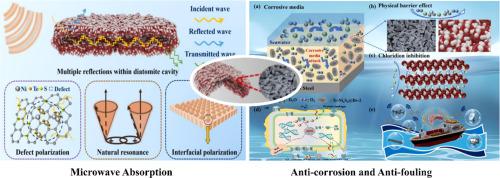光谱到热防御:Te-NixS6@Diatomite分层网络同时掌握微波吸收,耐腐蚀,抗菌活性,和保温
IF 14.3
1区 材料科学
Q1 MATERIALS SCIENCE, MULTIDISCIPLINARY
引用次数: 0
摘要
非金属元素掺杂是一种非常有前途的调整复合材料介电性能的策略。该方法具有结构稳定性高、工艺重现性好等优点,在电磁波吸收领域引起了广泛的关注。在本研究中,碲掺杂被引入到具有分层孔结构的NixS6@De复合材料中,引起晶格畸变并产生大量缺陷,从而促进界面偶极子的形成。因此,所获得的材料在微波、紫外和红外光谱(平均反射率低至~ 4%)中表现出出色的吸收性能(在1.7 mm厚度下达到最小反射损耗- 43.54 dB,有效吸收带宽为5.19 GHz)。更重要的是,协同设计的缺陷结构有效地阻止了腐蚀物质的渗透,增强了电化学钝化效果,同时对硫酸盐还原菌的杀菌抑制率达到100%。此外,复合材料表现出显著的热稳定性,在300°C以上保持性能,并表现出各向异性隔热性能。这种多尺度缺陷工程范式为开发集成高效电磁衰减、耐腐蚀性、抗菌活性和热变异性的先进材料提供了一种通用的设计策略。本文章由计算机程序翻译,如有差异,请以英文原文为准。

Spectrum-to-thermo defense: Te-NixS6@Diatomite hierarchical networks simultaneously mastering microwave absorption, corrosion resistance, antibacterial activity, and thermal insulation
Doping with non-metallic elements represents a highly promising strategy for tailoring the dielectric properties of composite materials. Owing to its merits such as high structural stability and excellent process reproducibility, this approach has garnered significant attention in the field of electromagnetic wave absorption. In this study, tellurium doping was introduced into a NixS6@De composite with a hierarchical pore structure, inducing lattice distortion and creating abundant defects, thereby promoting the formation of interfacial dipoles. As a result, the obtained material exhibits outstanding absorption performance across microwave (achieving a minimum reflection loss of −43.54 dB at 1.7 mm thickness and an effective absorption bandwidth of 5.19 GHz), ultraviolet, and infrared spectra (with a low average reflectivity of ∼4%). More importantly, the synergistically engineered defect configuration effectively impedes the penetration of corrosive species, enhances the electrochemical passivation effect, and simultaneously enables a 100% sterilization inhibition rate against sulfate-reducing bacteria. Furthermore, the composite demonstrates remarkable thermal stability, maintaining performance above 300 °C, and exhibits anisotropic heat insulation properties. This multi-scale defect engineering paradigm offers a universal design strategy for developing advanced materials integrating efficient electromagnetic attenuation, corrosion resistance, antibacterial activity, and thermal variability.
求助全文
通过发布文献求助,成功后即可免费获取论文全文。
去求助
来源期刊

Journal of Materials Science & Technology
工程技术-材料科学:综合
CiteScore
20.00
自引率
11.00%
发文量
995
审稿时长
13 days
期刊介绍:
Journal of Materials Science & Technology strives to promote global collaboration in the field of materials science and technology. It primarily publishes original research papers, invited review articles, letters, research notes, and summaries of scientific achievements. The journal covers a wide range of materials science and technology topics, including metallic materials, inorganic nonmetallic materials, and composite materials.
 求助内容:
求助内容: 应助结果提醒方式:
应助结果提醒方式:


